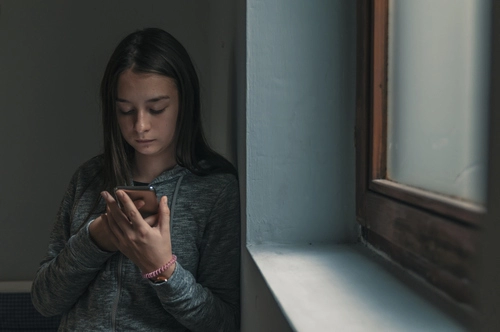1. Select a discrete app icon.

notes
Understanding Teen Dating Violence
A guide to recognizing abuse when it happens to young people
- Feb 10, 2021

Teens and young adults are the most at-risk age groups for dating and domestic violence. According to the Bureau of Justice Statistics, abusers most often target women ages 18 to 24 (though all gender-identities can be targeted by abusers). And according to LoveIsRespect.org, girls and young women between the ages of 16 and 24 experience the highest rate of intimate partner violence, almost triple the national average. One in three girls in the U.S. will be a victim of physical, emotional or verbal abuse from a dating partner,
Dating violence can be especially sinister because young people are often new to relationships, more trusting, more impulsive and may not have learned what healthy boundaries look like. They may be making adult decisions on their own for the very first time. An abuser may prey on this vulnerability, which is why it’s so important teens, and their parents or caregivers, learn the warning signs of abuse and point them out if present.
What Does Dating Violence Look Like?
Domestic violence encompasses dating violence, also called dating abuse, which is typically seen among younger and unmarried individuals. By definition, dating violence is the same as domestic violence—a pattern of control and coercion that can include physical violence as well as verbal, psychological, sexual, reproductive, financial and spiritual abuse.
A relationship where one partner feels controlled by the other, or where the victim feels unsafe with their partner, is not a healthy one and denotes abuse. Some red flags of dating abuse young adults should look out for include when ...
- Your partner demands you run things by them before doing them
- Your partner threatens you
- Your partner checks your phone or email, or demands to know your password to such things
- Your partner makes you feel guilty to get their way
- Your partner has been physically aggressive or violent with you
- Your partner pressures you into doing things you aren’t comfortable with
- Your partner blames you for everything that goes wrong
- Your partner calls you names and puts you down
- Your partner wants to be with you all the time and expresses frustration if you want to spend time away from them
- Your partner displays anger frequently and in a way that scares you
- Your partner incessantly calls or texts you
- Your partner needs to know where you are at all times
Red Flags Parents May See
Parents or caregivers may notice signs of dating violence before their child does. They could look like your teen...
- Losing interest in activities they once enjoyed
- Becoming more critical of themselves
- Becoming increasingly secretive and unwilling to share things with you
- Changing their appearance in a way that seems out of character
- No longer showing interest in friends
- Doing poorly in school
- Experiencing increased depression and anxiety
- Showing up with unexplained injuries or bruises
- Apologizing for their partner’s behavior, or minimizing it, when you question them about it
- Moving quickly in the relationship (talks of being in love or “soulmates,” moving in together, marriage or even wanting to start a family soon into the relationship)
- Expressing their partner has jealousy issues
- Needing to be constantly in communication with their partner
- Becoming isolated and distant from you and their friends
Technology and Teen Dating Violence
Almost every teen these days has access to a smartphone or computer, and most are active on social media sites like TikTok, Instagram and Facebook. Technology is another way abusive partners can control, degrade, harass or otherwise abuse their victims.
According to a study from the Urban Institute Project, 25 percent of dating teens have been victimized by their partners through technology. Of those, more than half of the victims said they were also physically abused. Only 9 percent of teens of digital abuse sought help, according to the report, and it was rarely from their parents or teachers.And much higher incidences of digital abuse from a dating partner were reported among LGBTQ youth compared to heterosexual teens.
Online abuse tactics can include:
- Using social media to monitor a partner’s whereabouts or track friendships
- Constant texting
- Coercing a partner into sending explicit selfies
- Coercing a partner for sex
- Sending degrading or threatening messages
- Demanding passwords to email and social media accounts
- Tampering with a partner’s social media account without their permission
Revenge Porn
Speaking of technology, abusers may also employ an especially disturbing abuse tactic called revenge porn, combining digital abuse and sexual abuse. Revenge porn is when a partner threatens to or actually does share explicit photos of a victim with the victim’s family members, friends, boss or the entire world without the subject’s permission. It’s a way to control, humiliate, discredit or coerce a victim to do something the abuser wants them to do, or possibly return or stay in a relationship.
Revenge porn has grown increasingly more prevalent as technology and social media become constants in our lives. The same study from above found a third of those who experienced digital abuse also experienced sexual coercion from their partner.
If you’re a victim of revenge porn, you should consider reaching out to a domestic violence advocate before calling police, security expert Spencer Coursen tells DomesticShelters.org. Having this liaison on your side will more likely result in police taking effective action.
There is also form on Google you can fill out requesting an image of yourself be removed. You can also reach out to the End Revenge Porn Crisis Line for additional help.
It’s Important to Talk About It and to Believe Teens
If a parent or caregiver recognizes possible signs of dating violence, they should talk to their teen immediately with both “concern and unwavering love,” says Anna Marjavi, program manager with Futures Without Violence.
“Let them know, ‘I’m concerned about you and for these reasons, and these are things I’ve noticed.’ If they’re defensive or deny it, just let them know you’re there for them and they can always come to talk to you about this.”
Statistics show that only a third of teens are likely to disclose dating violence or abuse to a trusted adult, friend or the police but not all of these teens will be believed. It’s important to take accounts of dating abuse seriously because abusers almost always escalate their tactics.
Here are some resources a parent, caregiver or teacher may want to use to help teens learn about recognizing a healthy relationship and drawing boundaries with a partner:
- Free toolkits from LoveisRespect.org.
- Read one of these five young adult novels with your teen with themes that center on dating violence and abuse.
- Watch a show like Netflix’s You with your teen that provides a roadmap to dating violence (warning: this show has images of violence and is recommended for only those age 16 and above).
- Show teens The Halls, a web series created by teens that talks about masculinity, relationships and trauma.
- Have this talk with your college-age kid.
- Recognize what abusive texts sound like.
Donate and change a life
Your support gives hope and help to victims of domestic violence every day.
It’s Never Too Early
According to a poll on DomesticShelters.org, nearly 60 percent of the respondents said they already did or plan on talking to their child about boundaries and consent before the age of 4. Advocates agree that starting the conversation early can have a profound impact on lowering a teen’s chances of experiencing dating violence later on. Learn ways to start this conversation here. You may also want to check out the book Girl Up, for teens, and this picture book for the younger crowd.
What to Do If You’re Experiencing Teen Dating Violence
Telling someone you trust is the first step. Be it a parent, teacher, other trusted adult or an advocate at a hotline (find one near you here or call the National Domestic Violence Hotline at 800-799-SAFE) it’s important not to keep this a secret.
An order of protection can send a clear message to an abusive partner to stay away, and anyone over 18 can get one. Those under 18 can also get an order of protection, though the rules for filing for one varies by state–in some states, you will need an adult to accompany you.
For more tips on domestic violence as it affects children and teens, check out the Children and Teens section of our website.
We've prepared a toolkit "Understand Teen Dating Violence" to help you understand even more what TDV is so you can better assess your relationship and understand your situation.
Looking for someone to speak with? Enter your location to find phone numbers for domestic violence experts in your area.
Have a question about domestic violence? Type your question below to find answers.







